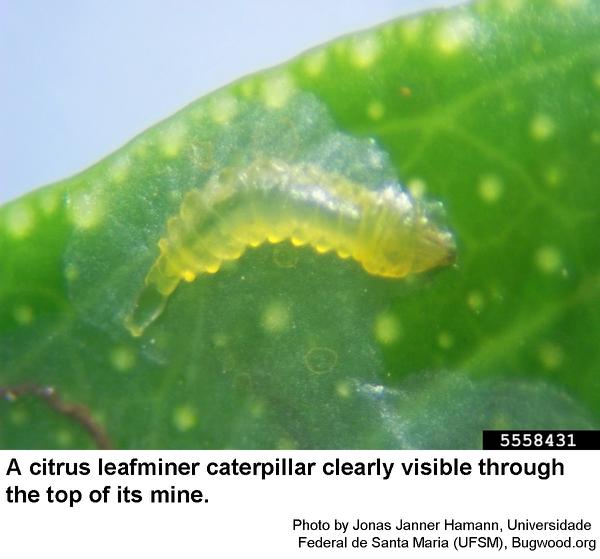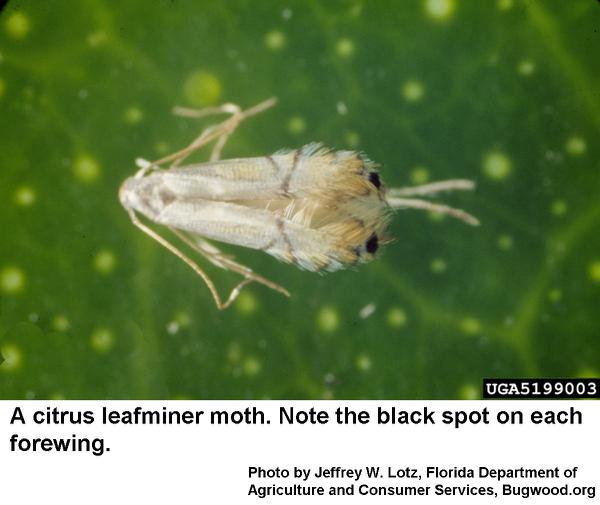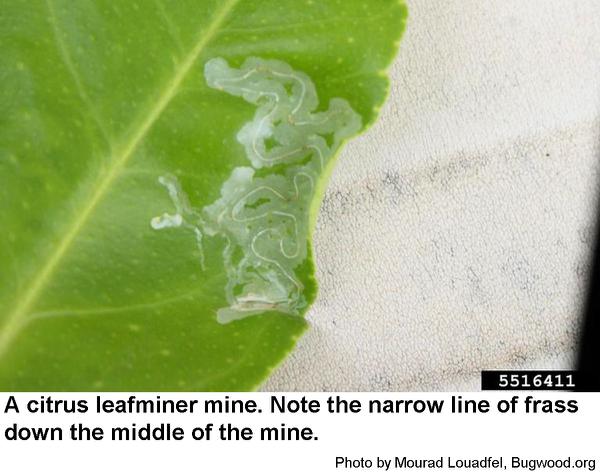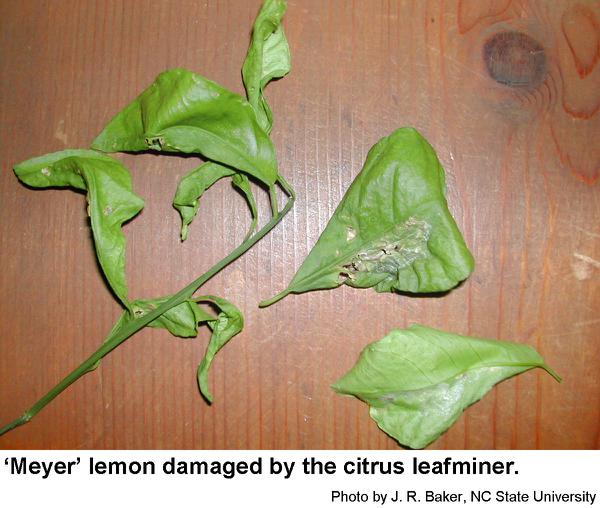Description and Biology
The citrus leafminer, Phyllocnistis citrella, is a relatively new pest in North Carolina. It was first discovered in the United States in Florida in 1993. The tiny caterpillars feed just under the epidermis, leaving a cellophane-like, transparent covering over the mine. Each leafminer produces a meandering mine that has a line of pale frass down the middle so that the mines resemble an aerial view of a mountain road with numerous switchbacks and a no-passing line between the lanes. Eventually the leafminer emerges from the mine (the spot where it emerges is killed so that a brown spot is formed on both sides of the leaf), crawls to the edge of the leaf, and folds it over to form some protection. The tiny caterpillar then pupates and a tiny moth emerges some 7 to 21 days later. The moths are tiny (about 1/8 inch long), silvery, with brown markings and a distinct black spot at the end of each wing. The mining and leaf rolling cause infested leaves to be greatly distorted. Citrus leafminer moths are most active during the morning but are usually not noticed. After mating, females lay one egg at a time on new, tender leaves. Eggs hatch about a week later, and the extremely small caterpillar bores into the leaf to feed, forming an almost invisible mine. These caterpillars molt four times as they grow in the 2 to 3 weeks they spend in the mines during which time the mines become much more noticeable. We have several generations per year in North Carolina.
Host Plants
Citrus leafminers infest on oranges, mandarins, lemons, limes, grapefruit, kumquat and calamondin as well as other related plants. Citrus leafminers do not kill citrus plants, but they make them look awful. Young trees that have more succulent foliage tend to be more heavily damaged. Constant grooming of container-grown citrus encourages citrus leafminers as new growth is attractive to the moths for egg laying.
Residential Recommendations
Citrus leafminers are often most damaging when they first arrive. Natural biological control agents such as very tiny parasitic wasps help suppress these leafminers. Do not prune off leaves damaged by citrus leafminer since undamaged areas of leaves continue to produce energy for the tree. Insecticides containing imidacloprid are effective for this leafminer. However, citrus red mites and other spider mites sometimes become unusually abundant after an application of imidacloprid so be alert to this possibility.
References
- Citrus Leafminer. Grafton-Cardwell, E. E. et al. 2010 (revised). How to Manage Pests, Pests in Gardens and Landscapes. University of California Agriculture & Natural Resources.
- Common name: citrus leafminer, scientific name: Phyllocnistis citrella Stainton (Insecta: Lepidoptera: Gracillariidae: Phyllocnistinae). Heppner, J. B. and R. R. Fasulo. 2016. Featured Creatures. Entomology & Nematology, FDACS/DPI, EDIS. Publication Number: EENY-38.
- Extension Plant Pathology Publications and Factsheets
- Horticultural Science Publications
- North Carolina Agricultural Chemicals Manual
For assistance with a specific problem, contact your local Cooperative Extension Center
This Factsheet has not been peer reviewed.
Publication date: Oct. 21, 2017
Reviewed/Revised: Aug. 3, 2022
Recommendations for the use of agricultural chemicals are included in this publication as a convenience to the reader. The use of brand names and any mention or listing of commercial products or services in this publication does not imply endorsement by NC State University or N.C. A&T State University nor discrimination against similar products or services not mentioned. Individuals who use agricultural chemicals are responsible for ensuring that the intended use complies with current regulations and conforms to the product label. Be sure to obtain current information about usage regulations and examine a current product label before applying any chemical. For assistance, contact your local N.C. Cooperative Extension county center.
N.C. Cooperative Extension prohibits discrimination and harassment regardless of age, color, disability, family and marital status, gender identity, national origin, political beliefs, race, religion, sex (including pregnancy), sexual orientation and veteran status.





